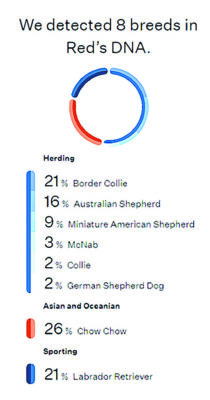My family has always rescued dogs. From the time I was little, I can recall the click-clack of paws on our tile floors, floating tufts of various colored hair, and the early morning barking which disturbed me from slumber. Rescuing dogs has been one of the greatest things my family has done, for the dogs sure, but especially for us. We are proud that we are able to bring these troubled animals to a home where they will be safe and loved. However, perhaps the biggest disappointment when it comes to rescuing is that we rarely – if ever – truly know our dogs.
I do not mean in a personality aspect. Anyone who has a pet knows that they often make their likes and dislikes – and quirks – very clear. What I mean is rescue animals rarely come with a detailed, full genetic report. There have been times where we are lucky to even guess at their age or place of origin. My mother, who prides herself on being a dog encyclopedia, very often can determine to some extent what breed or breeds a dog might be. This is the method we have used thus far in our pet owning journey, but we were all stumped when we recently adopted our newest dog.
This is Red! We rescued him from a group called A New Chance Animal Rescue, a foster home rescue based in Bedford Hills. We know he hails from Louisiana, was one of a litter of seven, and has come a long way from being cripplingly shy and contact-avoidant to the mushy, attention lover he is today. When we first saw him, we had guesses as to what he could potentially be. Breeds such as Lab, Shepherd, even Chow Chow were options. My mother’s skills were truly put to the test as we stared into his golden brown eyes. However, for as much as we felt certain about his personality, we were completely stumped on what breed or breeds he could be. He was truly our first mystery mutt.
For as helpful and experienced as the rescue agency is, they – like most facilities – cannot offer genetic screening for their animals. While shelters and rescue agencies do their best to provide as much information as possible, oftentimes a lack of resources and support mean that they are just as limited as the typical homeowner might be in cracking down on what breed a dog is. Priority is given to ensuring the health, welfare, and well-being of potential adoptees. This is a noble task, but leaves little room for the in-depth exploration of a dog’s history that one might receive from other sources such as a breeder.
This is not to promote breeding over rescuing. I firmly believe in the healing power of animal rescue and will always promote it first and foremost. And thankfully, many companies have made it possible for adopters to determine for themselves what exactly their dog is made of. For our family, we turned to the DNA test kit Wisdom Panel.
DNA test kits have gained a lot of popularity in recent years as we all look for answers to where we come from. Pet DNA kits are no different, and have boomed as a market to allow pet owners to discover much more about their animals. Red being the first dog we could not really identify sparked our interest in pursuing a more scientific approach. I was able to order a Wisdom Panel kit online. The company offers a variety of tests – including one for cats – depending on what information you are looking for. Because we had never done a DNA test before, we opted for their Essential Kit, which included dog breed identification, as well as information on traits and risk assessment for genetic diseases.

We were sent two swabs in the mail, as well as packaging to store them in and a box and return label. In order to gather DNA from Red, we needed to swab the inside of his cheek for several seconds. While he is a very good boy, this was not exactly his favorite part of the process, so I do recommend having a second person available to help distract your pet while collecting a swab. (It is not a painful process, but your pet might be a little confused and squirmish!) We waited for the swabs to fully dry and then repacked them in the box to return to Wisdom Panel’s labs. When the results came in, we were all shocked.
According to the results, Red consisted of eight breeds – far more than we had anticipated! He also had some surprising DNA. We had been right that he consisted of breeds like Chow Chow and Lab but were also surprised to learn he was 1/5 Border Collie, a breed which had not even crossed our minds. There were also some unexpected breeds which turned up, such as a McNab, which none of us had heard of before. The test was able to provide a type breakdown as well, indicating that his breeds consist of mostly “herding” dogs, as well as “Asian and Oceanian” and a little bit of “sporting”. We were relieved to learn that he did not test positive for a variety of potential health complications. We even learned a few interesting facts about his traits, including what genes contributed to his brownish-red color, why he has a certain number of toes, and where some of his behaviors likely stem from.

We were blown away by just how much we were able to learn from this experience. Mixed bag or purebred, a lot can be gained from understanding your pet’s background, including how to be an even better pet owner in the future. For our family, doing a pet DNA test offered a lot of answers, and we can confidently say he is no longer a “Mystery” mutt!


















